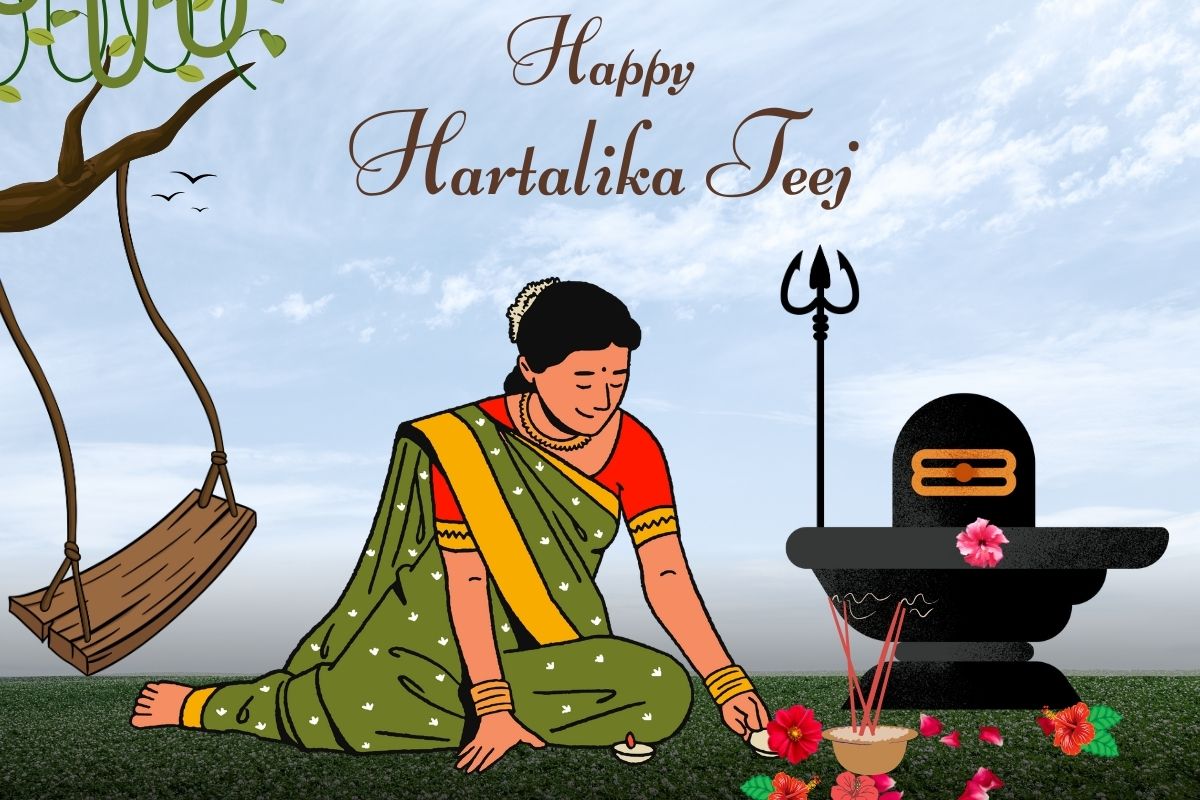
Hartalika Teej Vrat 2025: Significance, Puja Vidhi, and Fasting Rituals for Indian Women

Hartalika Teej Vrat is one of the most important Hindu holidays for ladies, both married and single, all over India. This vrat is very important to both the spirit and the culture. It takes place during the Shukla Paksha Tritiya of the Bhadrapada month. Women do puja and fast without water to worship Goddess Parvati and Lord Shiva. The vrat is a sign of a happy marriage, good fortune, and the joys of a happy married life.
Table of Contents
ToggleThe Mythological Importance of Hartalika Teej
Hindu scriptures say that Hartalika Teej is very closely related to the celestial union of Lord Shiva and Goddess Parvati. The story goes that Goddess Parvati did a lot of penance in the Himalayas to earn Lord Shiva as her husband. Lord Shiva was impressed by her undying devotion and accepted her as his wife. The name “Hartalika” comes from the words “Harat” (abduction) and “Aalika” (female acquaintance).
The myth says that Goddess Parvati’s friend led her into the woods to keep her from being married to Lord Vishnu against her choice. During this time, Parvati practiced extreme austerity and pondered on Shiva, which led to their marriage. As a result, women observe Hartalika Teej Vrat in the hopes of having a strong, happy marriage like Shiva and Parvati.
Also read: Parineeti Chopra and Raghav Chadha Expecting Their First Child: A Joyous Announcement
When is Hartalika Teej Celebrated?
The Gregorian calendar says that Hartalika Teej happens on the third day (Tritiya) of Shukla Paksha in the month of Bhadrapada, which is normally around August or September. The timing of the vrat is important since it falls at the same time as the start of the holiday season in India, which comes after the monsoon harvest. In 2025, women in areas like Uttar Pradesh, Bihar, Rajasthan, Madhya Pradesh, and Maharashtra will celebrate Hartalika Teej in a big way.
Significance of Hartalika Teej Vrat
The vrat is very important in Indian homes for many reasons:
- For married women: Tt is done for the long life, wealth, and health of their spouses.
- For single women: it is said that fasting on Hartalika Teej will help them find a good spouse who is faithful and brings peace.
- Spiritual Meaning: The vrat cleanses the soul, boosts self-control, and calls down benefits from above.
- Cultural Value: It strengthens India’s cultural history by showing that festivals are times to connect, enjoy being a lady, and show devotion.
Hartalika Teej Vrat Rituals
There are traditional traditions that are a little different in different parts of the country for the celebration of Hartalika Teej, but they all have the same meaning and dedication.
1. Nirjala Fasting
Women follow a nirjala vrat, which means they don’t eat or drink anything for 24 hours. This level of self-control shows how much they love Goddess Parvati.
2. Early Morning Preparations
Women start the vrat early in the morning by bathing and dressing up in bright clothes, such green or red sarees, which stand for fertility, wealth, and happiness in marriage. They also wear traditional jewelry and put mehendi on their hands, which makes the celebration even more joyous.
3. Puja Vidhi
The puja is done with care and devotion:
- People make an idol or clay statue of Lord Shiva and Goddess Parvati and decorate it with flowers, kumkum, and other gifts.
- As part of the traditions, women give fruits, sweets, betel leaves, and seasonal fruits and vegetables.
- People say special prayers and tell the story of the Hartalika Teej Vrat Katha, which focuses on the story of Parvati’s penance.
- Women sing religious hymns and do folk dances to honor the union of the gods.
4. Jagran and Nightlong Devotion
Many devotees remain up all night chanting bhajans and hymns to honor Lord Shiva and Goddess Parvati. The vigil is a sign of spiritual readiness and dedication.
5. Breaking the Fast
Only the next morning, after praying to the gods and asking for their blessings, is the vrat broken. After that, women eat prasad and simple sattvik cuisine.
Regional Celebrations of Hartalika Teej
- North India (Uttar Pradesh, Bihar, Rajasthan): In North India (Uttar Pradesh, Bihar, and Rajasthan), women wear festive clothes, go to temples, and do group pujas. Cultural events and community meetings are also part of the celebration.
- Madhya Pradesh and Maharashtra: In Madhya Pradesh and Maharashtra, there are long processions with statues of Lord Shiva and Parvati. Women sing traditional tunes and decorate swings.
- Nepal: Hartalika Teej is a big deal in Nepal. Women go to fairs, sing traditional songs, and dance, making it one of the most exciting festivals of the year.
Foods and Offerings Associated with the Vrat
Women who are fasting for nirjala do so, but offerings are very important to the puja. Fruits, coconut, sweets like ghevar and ladoos, and seasonal treats are put in front of the gods. After the fast, family members share these gifts called prasad.
The Importance of Mehendi and Traditional Clothing
Putting on mehendi is an important part of Hartalika Teej. Women paint beautiful henna designs on their hands and feet to show good luck and happiness. Green bangles, sindoor, bindis, and traditional sarees make the holiday mood better and show how happy a couple is in their marriage.
Modern-Day Observance
In current times, the vrat’s meaning has stayed the same, but the way it is celebrated has changed to fit modern living. In the city, families hold group pujas in temples or community centers, when women get together to do rituals. People also utilize social media to send holiday wishes, songs, and pictures, which keeps traditions alive in the digital world.
Also read: Supreme Court Revises Stray Dog Directive: From Shelter Relocation to Designated Feeding Zones
Conclusion
Hartalika Teej Vrat is not only a religious holiday; it is also a cultural holiday that praises women, devotion, and the sanctity of marriage. Women fast, pray, and do rituals to ask Goddess Parvati and Lord Shiva for blessings for their marriages and their health in general. Hartalika Teej is still loved by women of all ages in India. Its deep-rooted traditions, lively festivities, and ageless spiritual ideals bring women together in faith and devotion.






